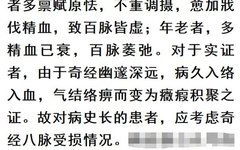
Chronic illnesses that do not heal require attention to the Extraordinary Meridians
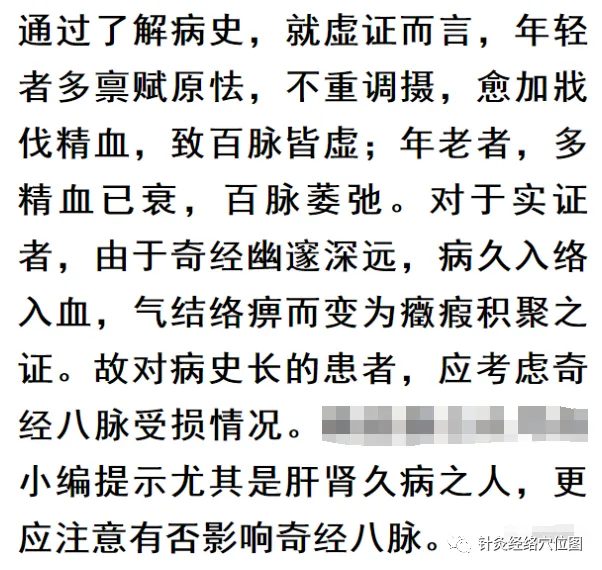
Complex and difficult diseases require consideration of the Extraordinary MeridiansEight Extraordinary Meridians often present multiple symptoms that can sometimes be confused with those of the regular meridians. Conventional treatment methods may not be effective. For example, in cases of persistent uterine bleeding, using herbs to regulate the spleen and stomach or hemostatic herbs may not yield results. Instead, employing methods to elevate the Yang of the Du (Governing) Meridian and regulate the Qi of the Chong (Penetrating) Meridian, without treating the spleen and stomach but focusing on the Extraordinary Meridians, often leads to improvement.Carefully examine the location of the disease and differentiate patterns based on the Extraordinary Meridians
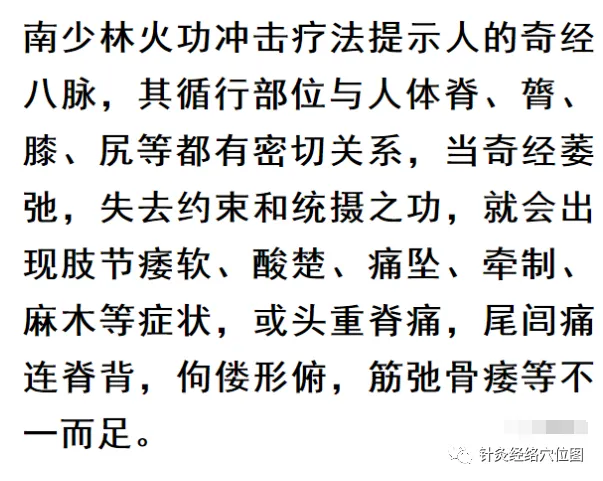
Acupuncture meridian point diagrams suggest that generally, those who primarily exhibit gait issues are often attributed to the Yang Qiao and Yin Qiao Meridians; those with lower back pain and hip discomfort are often attributed to the Chong, Ren, and Da Mai Meridians; and those with back pain and stooping are attributed to the Du Meridian. Other conditions, such as issues arising from the Chong and Ren Meridians traveling upward through the abdomen, with Qi of the Chong penetrating the heart, or masses in the lower abdomen, are related to the Chong and Ren Meridians; the Da Mai encircles the waist, and conditions like chronic urinary incontinence or prolonged menstrual bleeding are associated with it. The Yang Wei and Yang Qiao Meridians run along the sides of the body, while the Yin Wei and Yin Qiao travel up the inner thigh, with imbalances in cold and heat, gait abnormalities, weakness, and heart pain often attributed to the Qiao and Wei Meridians. In summary, the pathologies of the Extraordinary Meridians exhibit unique manifestations, and one should be adept at summarizing and differentiating symptoms.Examine the whole and integrate with the Extraordinary Meridians
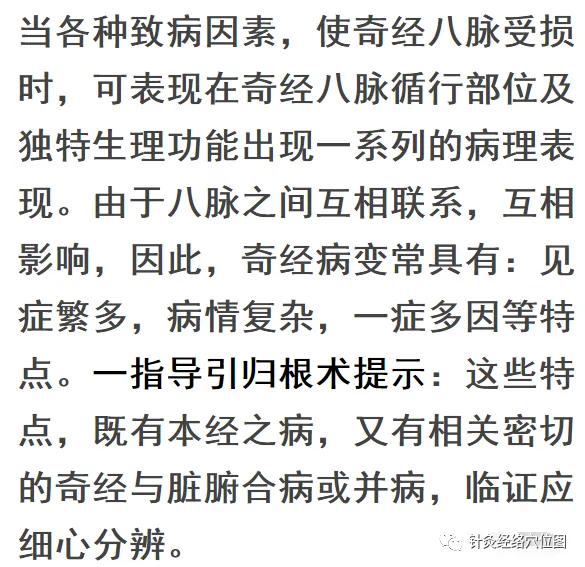
Furthermore, the theory of the Eight Extraordinary Meridians shares common principles with fundamental TCM theories, such as the balance of Yin and Yang, the rise and fall of Qi, and the vacuity and repletion of the meridians. However, it also possesses its own relatively unique theoretical characteristics, which can be summarized in six aspects.The Eight Extraordinary Meridians are a four-dimensional structural system of the human body
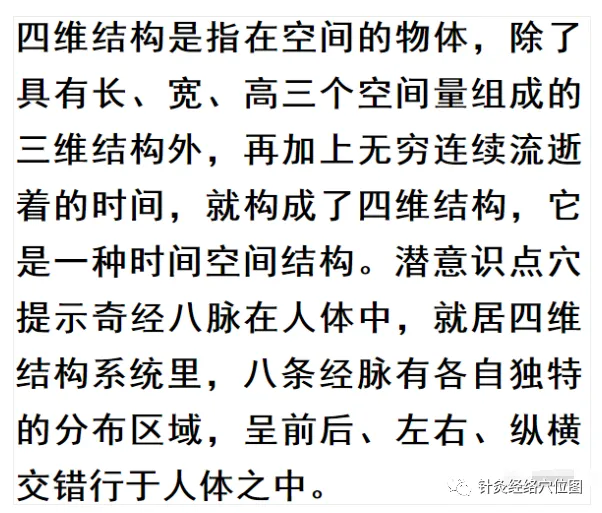
If we consider the human body as a coordinate system, the Chong Meridian serves as the vertical axis, running from the head to the feet, guiding Qi upward and blood downward, acting as the sea of the meridians. Following the Chong Meridian is the Du Meridian, which runs along the spine and governs the Yang Meridians, while preceding the Chong is the Ren Meridian, which runs along the midline of the chest and abdomen, receiving all the Yin Meridians, acting as the sea of the Yin Meridians. The Da Mai serves as the horizontal axis, encircling the body and binding all the meridians to prevent erratic flow. The Yin and Yang Meridians connect all the Yin and Yang channels, resembling a network, serving as the framework of the body. The Yin and Yang Qiao Meridians both originate from the heel and run along the sides of the body, managing the meridians on the same side. Thus, the system of the Eight Extraordinary Meridians connects, governs, combines, and regulates the twelve regular meridians from a higher level, reflecting the holistic view of TCM.The role of the Eight Extraordinary Meridians in the overall balance of Yin and YangThe Ren and Du Meridians among the Eight Extraordinary Meridians play a crucial role in regulating the balance of Yin and Yang Qi in the body. They run directly along the front and back of the body, governing all Yin and Yang channels, allowing for the intersection of Yin and Yang, the rise and fall of Qi, and maintaining the dynamic balance of Qi and blood between the twelve regular meridians and the Eight Extraordinary Meridians.The role of the Eight Extraordinary Meridians in the regulation of Qi rise and fall

The role of the Eight Extraordinary Meridians in maintaining the body’s meridian connectionsThe Yang and Yin channels of the body are governed by the Du and Ren Meridians. However, the scattered branches of the Yin and Yang channels rely on the Wei Meridians to maintain their connections. As noted in the Suwen: Yin Yang Classification, Wang Bing commented: “Wei means to maintain.” This indicates that the Wei Meridians circulate throughout the body, maintaining the connections of all Yin and Yang channels. The Yang Wei Meridian connects all Yang channels to the Du Meridian, governing the exterior; the Yin Wei Meridian connects all Yin channels to the Ren Meridian, governing the interior. Together, these two meridians play a role in maintaining the relationship between the exterior and interior. As stated in the Study of the Eight Extraordinary Meridians: “The Yang Wei Meridian originates from the convergence of all Yang channels, ascending from the exterior to the Wei level, thus serving as the framework of the body.” The Wei Meridians run between the Yin and Yang channels, linking the body’s meridians and regulating the flow of Qi and blood.The role of the Eight Extraordinary Meridians in regulating the body’s movement and stillnessThe two Qiao Meridians among the Eight Extraordinary Meridians have Qi that rises from below to above, and wherever they pass, they are closely related to the body’s movement system. The Yin and Yang Qiao Meridians coordinate and cooperate, regulating the body’s movement functions. Additionally, the fluctuations in the Yin and Yang Qi of the Qiao Meridians are closely linked to the movement of Wei Qi, which circulates from the five zang organs. When the Yin is exhausted and returns to the Yang, it must ascend through the Qiao Meridians to the eyes. If there are pathogens in the five zang organs, affecting the function of Wei Qi to circulate during the day in Yang and at night in Yin, it will lead to an imbalance in the Yin and Yang Qi of the Qiao Meridians. Therefore, when the functions of the two Qiao Meridians are normal, the body’s movement and stillness functions remain normal.
The relationship of the Eight Extraordinary Meridians with the Zang-Fu organs

The Eight Extraordinary Meridians are associated with the brain. The brain is an extremely important organ in the human body, and traditional Chinese medicine has recognized its significance for a long time. The Ling Shu: Sea Theory states: “The brain is the sea of marrow,” clearly indicating that the upper boundary of the brain is at the Baihui (Hundred Meetings) point on the crown, descending to the Fengfu (Wind Palace) point. The brain cavity is filled with marrow, and the spinal marrow below the Fengfu point is connected to the brain, collectively referred to as the brain and spinal marrow. As stated in the Ming Dynasty’s Introduction to Medicine: “The brain is the sea of marrow; all marrow belongs to the brain, thus from the brain to the tailbone, it is the pathway of the essence and marrow.” This suggests that the formation of brain marrow is derived from congenital essence and nourished by the refined essence of food and water. The Ling Shu: Meridian Chapter states: “When a person is born, essence is first formed, and when essence is formed, brain marrow is born.” Regarding the function of brain marrow, many physicians throughout history have elaborated. Li Shizhen in the Ming Dynasty stated in the Compendium of Materia Medica: “The brain is the residence of the Yuan Shen (Original Spirit).” The Medical Canon of the Golden Mirror further clarifies: “The head is the chief of all Yang, positioned highest, containing brain marrow, and the brain is the residence of the Yuan Shen, governing the entire body.”
The brain governs the activities of all Zang-Fu organs through the meridian system, and the Eight Extraordinary Meridians play an important role in this connection. The Eight Extraordinary Meridians are closely related to the brain, both in terms of meridian pathways and their respective functions. The brain is the highest ruler of life activities in the human body, overseeing the activities of the five Zang and six Fu organs, while the Eight Extraordinary Meridians serve as the hub, playing a regulatory and connective role. Many diseases related to the brain can be effectively treated by addressing the Extraordinary Meridians. The Eight Meridians are associated with the liver and kidneys. The kidneys are the foundation of congenital essence, governing growth, development, and reproduction. Based on the abundance of kidney Qi, the Tian Gui (Heavenly Water) can begin to flow, promoting the smooth functioning of the Ren and Chong Meridians, hence the saying that “the kidneys are the foundation of the Chong and Ren Meridians.” All Eight Meridians are connected to the kidneys, making their role particularly important in the context of the Extraordinary Meridians. The liver governs blood storage and regulates the flow. When the flow is orderly, the Qi and blood of the Chong Meridian flourish, allowing the blood sea to overflow, leading to menstruation. After conception, menstruation ceases to nourish the fetus, and after childbirth, it can ascend to become breast milk. The Southern Shaolin Fire Kung Fu massage suggests that if there are issues with the liver channel, it often affects the Chong and Ren Meridians, impacting the stability of the blood sea, leading to a series of gynecological diseases. Given the close relationship between the Eight Extraordinary Meridians and the liver and kidneys in physiology, pathology, and meridian pathways, the ancients have said, “The Eight Meridians are subordinate to the liver and kidneys.” The Eight Meridians are also related to the spleen and stomach. The stomach is the sea of food and fluids, while the spleen governs transformation and transportation, facilitating the stomach’s movement of its fluids and also governs blood. When the stomach Qi is strong, the essence and Qi from food and fluids can continuously nourish the body’s normal activities, as the congenital essence relies on the refined essence from food and fluids. Therefore, the spleen and stomach, as the “foundation of postnatal life,” play an important role in the Eight Extraordinary Meridians.
In the lower right corner, please click to and “View”
and “View” Click the “Business Card” below to follow us
Click the “Business Card” below to follow us
Please click "View" to see me👇

